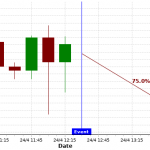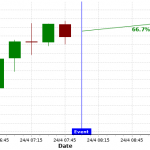 One of the biggest challenges faced by brokers is finding the best tools/methods to attract and convert new traders. With trading becoming increasingly more popular among Gen Z, it is this young group of up and coming traders that hold the most potential for brokers. To help better understand this unique demographic we spoke to Autochartist Sales Manager and new trader Neil Swanepoel.
One of the biggest challenges faced by brokers is finding the best tools/methods to attract and convert new traders. With trading becoming increasingly more popular among Gen Z, it is this young group of up and coming traders that hold the most potential for brokers. To help better understand this unique demographic we spoke to Autochartist Sales Manager and new trader Neil Swanepoel.
1. Tell us a little more about yourself?
My interest in trading began quite a while before I actually took the plunge. I was following a few trading subreddits and dabbled a bit in stocks but never really knew where to start, which I think is pretty typical of us GenZ traders. When I began my position at Autochartist I finally got the push I needed and opened a demo account. I watched The Wolf of Wall Street, made 4 successful demo trades and I was ready for the big leagues.
I was of course (as you can imagine) humbled within 2 days of trading. I think my highlight was successfully turning $100 into $40 in under an hour. I definitely made mistakes that most new traders fall victim to but personally I think these losses can teach people more about what not to do than they would ever get from having a successful start. Luckily for me I was in an environment where I had access to the Autochartist team which is full of extremely knowledgeable traders. With their guidance, and a lot of trial and error, I finally found a combination of tools that could be valuable to other beginner traders.
2. What motivated you to start trading?
I have been investing in South African stocks since the beginning of 2020. This was what got me interested in researching other stocks also. After I joined Autochartist I thought it was important to understand trading so that I had a better idea of the environment I was working in. The bug bit me and now, 2 years later, I trade different asset classes whenever I can.
3. What tools did you find most useful when starting out on your trading journey?
When I started I found identifying patterns quite difficult. I had no idea when to draw triangles, what the heck horizontal key levels were, etc. I sort of tried drawing random patterns that I thought were right. As you can guess, that did not work amazingly for me.
I then started using Autochartist’s market scanner and it helped me learn what I was looking for. It showed me opportunities which I started correlating with other research and I slowly started becoming more confident in what I was looking for. Even now as I am getting more comfortable I find myself using the Autochartist scanner for inspiration when I can’t see any opportunities.
4. In your experience, what was the biggest benefit you found when using the tools you have mentioned?
The simplicity. There are videos on how the tools work and it really made it easier for me rather than when I was staring at a blank chart.
5. What advice would you have for a broker who is struggling to move traders like yourself from demo to live accounts?
I think the best way is through education. I was a bit braver than most traders because I had tools at my disposal to help me and it is also an environment that I worked in.
For most traders they do not have that luxury. Showing opportunities that traders can correlate with research and helping them understand what they are looking at through simple language is, what I would say, is key. This is where Autochartist tools can really support a broker’s conversion.
6. In your opinion, what are the biggest challenges new traders experience?
Managing risk. It is near impossible (if not completely impossible) for a trader to be right 100% of the time, even if they have traded their whole life. The one thing that you can control is risk. If a trader only risks 1%-3% of their account at a time, it just takes one good trade to make up that loss. If a client loses 50% of their account on one trade or a few trades, they now need to make up 100% of their new balance just to break even. If traders understand stop losses and how to manage their risk, they have way more chances of being successful. This also stops them from getting discouraged and they see that they have the potential of a successful position, meaning that they are taking more trades and slowly growing their account instead of just blowing it on one trade and giving up.
The problems I faced when I started boiled down to two main things; where to put a stop loss and take profit, and how to calculate losses as either a percentage or a dollar amount. In terms of loss calculations, there are so many calculators online. I personally use the Autochartist risk calculator as I find it the easiest (I may be biased but from experience, it just works). It is also available in the MT5 platform which I use, so I do not need to open a new tab or go online to use it.
The way I decided on where to place ‘take profits’ and place ‘stop losses’ was based on Autochartist’s volatility analysis. It gave a high and low price depending on the volatility expected over 1 hour, 4 hours and 1 day. For example, if I took a long position and I wanted to hold the trade for the day, I would put my take profit just below the expected high and I would put my stop loss just below the expected low. That way my stop loss was not too close to where my entry point was and it would only trigger if there was an unexpected movement. If I was correct however, my take profit would execute and I would ensure that I was not setting unrealistic profit expectations.
7. What is the best advice you can give to a novice trader?
Learn as much as possible before you start. Do not trade a live account until you are comfortable trading on a demo account. Use all resources available to you from your broker. Don’t be greedy, rather take a small profit than a large loss. Never start trading with an insane amount of money. Most brokers offer Micro lots which you can trade with as low as 10$. When you are comfortable, then play around with larger amounts. Lastly but most importantly, manage your risk.

